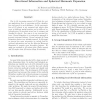Free Online Productivity Tools
i2Speak
i2Symbol
i2OCR
iTex2Img
iWeb2Print
iWeb2Shot
i2Type
iPdf2Split
iPdf2Merge
i2Bopomofo
i2Arabic
i2Style
i2Image
i2PDF
iLatex2Rtf
Sci2ools
ICPR
2006
IEEE
2006
IEEE
Invariant Features for 3D-Data based on Group Integration using Directional Information and Spherical Harmonic Expansion
Due to the increasing amount of 3D data for various applications there is a growing need for classification and search in such databases. As the representation of 3D objects is not canonical and objects often occur at different spatial position and in different rotational poses, the question arises how to compare and classify the objects. One way is to use invariant features. Group Integration is a constructive approach to generate invariant features. Several variants of Group Integration features are already proposed. In this paper we present two main extensions, we include local directional information and use the Spherical Harmonic Expansion to compute more descriptive features. We apply our methods to 3D-volume data (Pollen grains) and 3D-surface data (Princeton Shape Benchmark)
Computer Vision | Group Integration Features | ICPR 2006 | Invariant Features | Spherical Harmonic Expansion |
Related Content
| Added | 09 Nov 2009 |
| Updated | 09 Nov 2009 |
| Type | Conference |
| Year | 2006 |
| Where | ICPR |
| Authors | Marco Reisert, Hans Burkhardt |
Comments (0)

